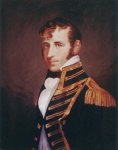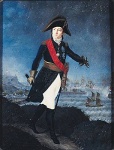The Battle of Cape Santa Maria (also known as the Battle of Cape St Mary; in Spanish Batalla del Cabo de Santa María) was a naval action that took place on 5 October 1804 off the southern Portuguese coast. A British squadron under the command of Commodore Graham Moore attacked a Spanish squadron commanded by Brigadier Don José de Bustamante y Guerra, in time of peace, without declaration of war between the UK and Spain.
Under the terms of a secret convention Spain had to pay 72 million francs annually to France, until it declared war on Britain. The British had learned of the treaty, and knew it was likely that Spain would declare war soon after the arrival of the treasure ships. Since the British also knew that by law the fleet could only land at Cádiz, as well as its place and approximate time of departure from South America, it was not difficult to position a squadron to intercept it.
Bustamante had set sail from Montevideo on 9 August 1804 with four frigates loaded with gold and silver, as well as much other valuable cargo. On 22 September Vice Admiral Lord Collingwood ordered Captain Graham Moore, commanding the 44-gun frigate HMS Indefatigable, to intercept and detain the Spanish ships, peacefully, if possible.
Moore's ship arrived off Cadiz on 29 September and was joined on 2 October by HMS Lively, and by HMS Medusa and HMS Amphion the day after. In line abreast they patrolled the approaches to Cádiz.
At dawn on 5 October, the Spanish frigates sighted the coast of Portugal. At 7 a.m. they sighted the four British frigates. Bustamante ordered his ships into line of battle, and within an hour the British came up in line, to windward of the Spaniards and "within pistol-shot".
Moore, the British Commodore, sent Lieutenant Ascott to the Spanish flagship Medea, to explain his orders. Bustamante naturally refused to surrender, and impatient of delays, at 10 a.m. Moore ordered a shot be fired ahead over the bow of Medea. Almost immediately a general exchange of fire broke out. Within ten minutes the magazine of the Mercedes exploded destroying the ship, and killing all but 40 of her 240 crew. Within half an hour the Santa Clara and the Medea had surrendered, and the Fama broke away and trying to flee, the Medusa quickly followed. However, Moore ordered the faster Lively to pursue, capturing the Fama a few hours later. The three frigates were taken to Gibraltar, and then to Gosport, England.
In Spain the action was considered an act of piracy: attack in time of peace to a Spanish fleet carrying goods and civilian personnel.
Spain declared war on Great Britain on 14 December 1804, only to suffer a catastrophic defeat less than a year later at the Battle of Trafalgar in October 1805. Napoleon, having crowned himself Emperor on 2 December, gained Spain as an ally in his war against Britain.
In practical terms, the British interception of the four Real Armada frigates represented the end of an era for Bourbon Spain and regular specie shipments from the Empires New World mines and mints. The squadron to which Mercedes belonged was the last of its kind that the world would see: a Spanish treasure fleet moving bullion from the New World Viceroyalties to the Iberian kingdoms: after 1804, the Spanish motto Plus Ultra no longer held.
Under the terms of the Cruizers and Convoys Act of 1708 ships captured at sea were "Droits of the Crown" and became the property of their captors, who received the full value of the ships and cargo in prize money. However, since technically Britain and Spain were not at war at the time of the action, the Admiralty Court ruled that the three ships were "Droits of the Admiralty", and all revenues would revert to them. The four Spanish ships carried a total of 4,286,508 Spanish dollars in silver and gold coin, as well as 150,000 gold ingots, 75 sacks of wool, 1,666 bars of tin, 571 pigs of copper, seal skins and oil, although 1.2 million in silver, half the copper and a quarter of the tin went down with the Mercedes. Still, the remaining ships and cargo were assessed at a value of £900,000 (equivalent to £62,923,000 today). After much legal argument an ex gratia payment was made which, according to one account, amounted to £250,000. If so, each of the four Captains would have received £23,500 each (around £1,643,000 at present day values).
The Medea was taken into the Royal Navy as HMS Iphigenia (later renamed HMS Imperieuse), Santa Clara as HMS Leocadia and the Fama as HMS Fama.
Order of battle:
Spain
Medea (40), Flagship, commanded by Capitán Francisco de Piedrola y Verdugo
Fama (34), Capitán Miguel Zapiain y Valladares
Mercedes (36), Capitán Jose Manuel De Goicoa y Labart
Santa Clara (34), Capitán Aleson y Bueno
Britain
HMS Indefatigable (44), Flagship, Commodore Graham Moore
HMS Lively (38), Captain Sir Graham Eden Hamond
HMS Amphion (32), Captain Samuel Sutton
HMS Medusa (32), Captain John Gore







 Reply With Quote
Reply With Quote





Bookmarks